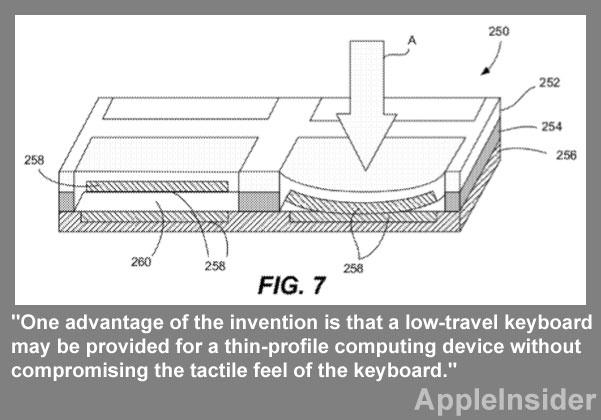Apple could make its notebook computers and keyboard accessories even thinner and lighter with a brand new take on the classic input method.
Apple's interest in reinventing the keyboard was revealed in a new patent application discovered this week by AppleInsider. Entitled "Single Support Lever Keyboard Mechanism," it describes a handful of ways that a keyboard could be shrunk in size without affecting its performance.
In the filing, Apple notes that the size of existing keyboards presents a challenge for the company as it attempts to design thinner, lighter and more attractive devices.
"It would be beneficial to provide a keyboard for a portable computing device that is aesthetically pleasing, yet still provides the stability for each key that users desire," the application reads. "It would also be beneficial to provide methods for manufacturing the keyboard having an especially aesthetic design as well as functionality for the portable computing device."
One of the most common keyboard types is the "dome switch," in which the key pushes down on a rubber dome located beneath the key. Other types of keyboards include capacitive, mechanical switch, Hall-effect, membrane, and roll-up, and each offer their own strengths and weaknesses in terms of two important categories: response (positive feedback that the key has been pressed) and travel (the distance needed to push the key).
Apple's solution is a single support lever keyboard mechanism, which the proposed invention says would allow the keyboard cap to be formed of almost any material, but would also provide stability to each key.
The application notes that the material chosen for the key caps is very important, not only for the appearance of the keyboard but also how it feels on users' fingers. The application includes a number of potential off-the-wall materials that could be used, like glass, wood, stone, and even "polished meteorite."

Regardless of the material, Apple's keyboard key caps would be held in place by a rigid support lever. With its design, the keys could have a total travel range of as little as 0.2 millimeters.
In another method, Apple describes a support lever holding the key cap that would be made of a flexible material. This support lever could be made of spring steel that could allow good tactile feedback to the user when they are typing.
The key cap and support lever would have an "elastomeric spacer" between them and a metal dome positioned below. The spacer would be made of a material such as rubber o silicone that would "provide a desirable and distinctive feel to the user when pressed," in addition to reducing rattling on the keyboard.
"The advantages of the invention are numerous," the filing states, adding: "One advantage of the invention is that a low-travel keyboard may be provided for a thin-profile computing device without compromising the tactile feel of the keyboard."
The filing, made public this week by the U.S. Patent and Trademark Office, was first filed by Apple in August of 2010. It is credited to Patrick Kessier, Bradley Hamel, and James J. Niu.


